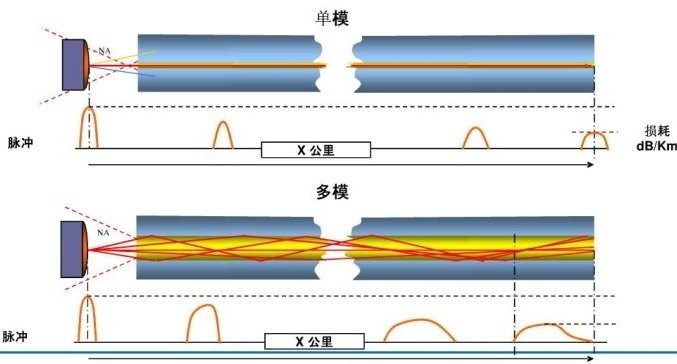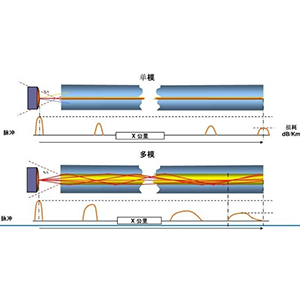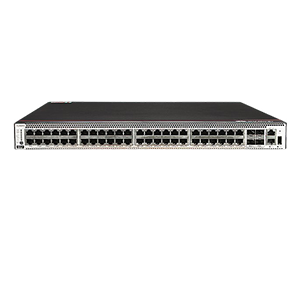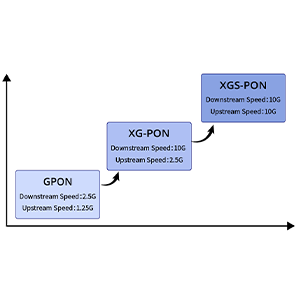Optical fiber communications undoubtedly play a key role in modern communications networks. This article will focus on the characteristics of single-mode fiber and its wide range of applications. We will first define the basic concepts of single-mode fiber, including its physical structure and waveguide mechanism, and explain its main differences from multi-mode fiber. We will analyze the excellent optical transmission characteristics of single-mode fiber such as low loss and high bandwidth, and illustrate its application advantages in long-distance transmission.
At the same time, we will also introduce different types of single-mode optical fibers, such as SMF-28, LEAF, etc., and compare their differences in parameters such as dispersion and power. In addition, we will describe common single-mode fiber connectors and their characteristics, and explain the technical requirements for connection and coupling. Finally, we will list the typical applications of single-mode optical fiber in long-distance transmission, 5G, FTTx and other fields, and provide relevant suggestions for the installation and maintenance of single-mode optical fiber.

Basic overview of single-mode optical fiber
Let me introduce to you the basic concept of single-mode optical fiber in detail: Single-mode optical fiber is a special optical fiber with a core diameter of only a few microns, which only allows one mode of light to propagate in it. Since the core diameter of single-mode fiber is very small, its transmission loss is very low and it can transmit higher bandwidth signals. Single-mode optical fiber is mainly used in long-distance, high-bandwidth optical fiber communication systems.
Structure and mechanism of single-mode fiber:
1. Physical structure:
- Single-mode optical fiber consists of a three-layer structure of core, cladding and protective layer.
- The core diameter is small, generally 8-10μm, and the cladding diameter is 125μm.
- The material is usually high purity fused silica glass.
2. Waveguide mechanism:
- The core refractive index of single-mode fiber is higher than the cladding refractive index, satisfying the total reflection condition.
- Only a single basic mode LP01) can be transmitted, and there is no high-order mode.
- Light waves propagate along the central axis of the core without multi-mode interference.
The main differences between single-mode fiber and multi-mode fiber:
1. Light source:
- Single-mode fiber uses a single-mode laser diode (LD) as the light source.
- Multimode optical fiber uses light emitting diodes (LEDs) or multimode laser diodes as light sources.
2. Core diameter:
- Single-mode optical fiber has a smaller core diameter (8-10μm) and only supports single-mode transmission.
- Multi-mode optical fiber has a larger core diameter (50/62.5/100μm) and can support a variety of high-order modes.
3.Transmission distance:
- Single-mode optical fiber can achieve long-distance (tens of km) and high-bandwidth transmission.
- Multi-mode optical fiber is suitable for medium and short distances (2-5km) and low bandwidth transmission.
4. Loss:
- Single-mode optical fiber has a lower loss of 0.2-0.4dB/km) and is more suitable for long-distance transmission.
- Multimode optical fiber has a higher loss of 1-3dB/km) and is more affected by modal dispersion.
5. Cost:
- The cost of single-mode optical fiber and related components is relatively high.
- Multimode optical fiber and related components have lower costs.
In short, single-mode optical fiber is widely used in long-distance, high-speed optical fiber communication systems due to its unique waveguide mechanism and performance advantages, and is the mainstream technology of modern optical fiber communication. Multimode optical fiber is more suitable for short-to-medium distance and low-speed application scenarios.
Optical transmission characteristics of single-mode optical fiber
Let me introduce to you in detail the optical transmission characteristics of single-mode optical fiber and its application advantages in long-distance transmission: The optical transmission characteristics of single-mode optical fiber include: low loss, high bandwidth, small dispersion, and strong anti-interference ability wait. The loss of single-mode optical fiber is very low, generally only about 0.2dB/km, so it can transmit longer distances. Single-mode fiber also has high bandwidth and can transmit signals up to 100Gbps. Single-mode fiber also has very little dispersion, allowing it to transmit signals at higher speeds. Single-mode optical fiber also has strong anti-interference ability, so it can be used in various harsh environments.
What are the transmission characteristics of single-mode optical fiber:
1. Low loss
- Single-mode optical fiber is made of high-purity fused silica glass with low material loss.
- In the 1310nm and 1550nm bands, the loss of single-mode fiber is only 0.2-0.4dB/km.
- This enables single-mode fiber to achieve long-distance transmission without relays.
2. High bandwidth
- Since single-mode fiber only supports transmission of a single basic mode, it does not produce modal dispersion.
- Coupled with the small material dispersion and waveguide dispersion, single-mode optical fiber can achieve a bandwidth of hundreds of GHz·km.
- This provides good transmission conditions for high-speed digital communication.
3. Low dispersion
- The dispersion coefficient of single-mode fiber is small, only about 17ps/nm·km in the 1310nm and 1550nm bands.
- This greatly reduces signal distortion caused by dispersion and improves transmission quality.
4. Low power consumption
- Single-mode fiber has high optical coupling efficiency and does not require much optical power to achieve long-distance transmission.
- This results in lower power consumption in the electro-optical and optical-electrical conversion processes, which is beneficial to improving system energy efficiency.
Advantages of single-mode optical fiber in long-distance transmission:
1. Long-distance transmission capability
- The low-loss characteristics of single-mode optical fiber enable it to achieve tens to hundreds of kilometers of relay-free transmission.
- This greatly reduces the deployment cost of relay equipment such as optical amplifiers and regenerators.
2. High bandwidth capacity
- The high-bandwidth characteristics of single-mode fiber provide sufficient transmission capacity for the backbone network.
- It can meet the growing user bandwidth needs and support the next generation of high-speed optical communication applications.
3. Stable transmission quality
- The low dispersion characteristics of single-mode fiber ensure the stability of signal quality during transmission.
- Reduces signal distortion problems caused by dispersion and improves transmission reliability.
4. Energy efficiency advantages
- The low power consumption characteristics of single-mode optical fiber help reduce the operating energy consumption of long-distance optical networks.
- This is very important for the construction of green and sustainable optical fiber communication networks.
In short, single-mode fiber, with its excellent low loss, high bandwidth, low dispersion and low power consumption characteristics, has shown obvious application advantages in long-distance, high-speed optical transmission, and is the ideal choice for realizing the next generation of high-performance optical networks. key technologies.
Types and properties of single-mode optical fiber
Let me introduce to you the performance differences of different types of single-mode optical fiber in detail: The main types of single-mode optical fiber are: standard single-mode optical fiber, dispersion-shifted fiber, non-zero dispersion-shifted fiber, etc. Standard single-mode fiber has poor dispersion characteristics and will produce large dispersion during long-distance transmission. Dispersion-shifted fiber and non-zero dispersion-shifted fiber have better dispersion characteristics and can effectively reduce the impact of dispersion on signals.
The performance of single-mode fiber mainly includes: loss, bandwidth, dispersion, bending resistance, etc. The loss of single-mode fiber is very low, generally only about 0.2dB/km. Single-mode fiber also has high bandwidth and can transmit signals up to 100Gbps. Single-mode fiber also has very little dispersion, allowing it to transmit signals at higher speeds. Single-mode optical fiber also has good bending resistance and can withstand large bending radii.
What are the common types of single-mode optical fibers:
1.SMF-28
- This is the most common and widely used standard single-mode fiber.
- The core diameter is 8.2μm and the cladding diameter is 125μm, suitable for 1310nm and 1550nm bands.
- The dispersion coefficient is about 17ps/nm·km in the 1550nm band.
2.LEAFLarge Effective Area Fiber)
- This single-mode fiber has a larger effective mode field area, up to 80-100μm^2.
- In the 1550nm band, the dispersion coefficient is about 4-6ps/nm·km, which is much smaller than SMF-28.
- Suitable for application scenarios such as WDM transmission and high-power optical amplification.
3.NZDSFNon-Zero Dispersion-Shifted Fiber)
- This kind of fiber has non-zero dispersion near 1550nm, about 2-6ps/nm·km.
- Can better compensate for dispersion and reduce the impact caused by dispersion.
- Commonly used in trunk transmission and DWDM wavelength division multiplexing systems.
4.DCFDispersion Compensating Fiber)
- This fiber is specifically designed to compensate for the dispersion of other standard fibers.
- It has a negative dispersion coefficient in the 1550nm band, generally between -80 to -100ps/nm·km.
- Used in series with standard optical fiber, it can effectively compensate for dispersion.
Comparison of performance of different single-mode optical fibers:
1. Dispersion characteristics:
- The dispersion coefficients of LEAF and NZDSF are significantly smaller than SMF-28, which is more conducive to long-distance and high-speed transmission.
- DCF has negative dispersion characteristics and can be used to compensate for the dispersion of other optical fibers.
2. Power handling capability:
- LEAF has a larger effective mode field area and can withstand higher optical power.
- Suitable for applications such as optical amplifiers and optical switches that require high optical power.
3. Attenuation characteristics:
- SMF-28 is the most common standard single-mode optical fiber, with a low attenuation of 0.2-0.4dB/km.
- The attenuation of special optical fibers such as LEAF and NZDSF increases slightly, generally between 0.25-0.5dB/km.
In short, different types of single-mode optical fibers have their own characteristics and are suitable for different application scenarios. They need to be selected and used according to actual needs. Engineers need to fully understand the performance differences of various types of optical fibers to optimize the performance of the entire optical transmission system.
What are the connector interfaces for single-mode optical fiber
Let me introduce to you in detail the common connectors of single-mode optical fiber and their connection technical requirements: There are two main connection methods for single-mode optical fiber: fusion splicing and connector connection. Fusion splicing is to melt the end faces of two optical fibers together to make the refractive index of the optical fibers continuous, thereby realizing the connection of the optical fibers. Connector connection is the use of fiber optic connectors to connect two optical fibers. The interfaces of single-mode optical fiber mainly include FC, SC, ST, LC, etc. The FC interface is a threaded interface, the SC interface is a bayonet connection interface, the ST interface is a plug-in interface, and the LC interface is a miniaturized interface.
Connector types for single-mode fiber:
1.FC(Ferrule Connector)
- Using threaded connection, it has high repeatability and stability.
- The interface diameter is 2.5mm, and the connection loss is usually less than 0.3dB.
2.SC(Subscriber Connector)
- Using push-pull connection, the operation is simple and fast.
- The interface diameter is 2.5mm, and the connection loss is usually less than 0.3dB.
3.LC(Lucent Connector)
- Adopts a push-pull interface with a small size of 1.25mm).
- High connection density allows more connections to be accommodated in a compact space.
- Connection loss is generally less than 0.2dB.
4.ST(Straight Tip)
- It adopts threaded connection and looks like a BNC connector.
- Connecting and disconnecting is relatively more convenient, but the repeatability is not as good as FC/SC.
- Connection loss is usually less than 0.5dB.
What are the technical requirements for single-mode optical fiber connection:
1. End surface cleaning
- The optical fiber end face must be kept clean to avoid additional losses caused by dust or dirt.
- Special fiber cleaning solvents and wipes are usually required for cleaning.
2.End face verticality
- The fiber end face needs to be highly vertical to reduce reflection and coupling losses.
- Through grinding and polishing processes, the end face verticality requirement ≤0.5° can be achieved.
3. End face alignment
- When connecting, the central axes of the two optical fibers need to be accurately aligned to maximize the coupling of optical power.
- Alignment accuracy ≤0.5μm can be achieved through connector mechanical structure and precision adjustment.
4. Connection stability
- The structural design and material selection of the connector must ensure a stable and reliable connection.
- Avoid optical coupling changes caused by temperature changes, mechanical vibration and other factors.
In short, single-mode optical fiber connections require strict technical control, including end face cleaning, end face verticality, end face alignment and connection stability. Only by meeting these requirements can we achieve low-loss, highly reliable optical fiber connections and ensure the high-performance operation of the entire optical transmission system.
What are the typical applications of single-mode optical fiber
Let me introduce to you the typical applications and advantages of single-mode optical fiber in various network application scenarios: Typical applications of single-mode optical fiber in networks include: long-distance transmission, metropolitan area networks, data center interconnection, optical fiber to Household etc. The low loss and high bandwidth of single-mode fiber make it ideal for long-distance transmission. The strong anti-interference ability of single-mode optical fiber makes it very suitable for metropolitan area networks. The high bandwidth of single-mode fiber makes it ideal for data center interconnects. The small size of single-mode fiber makes it ideal for fiber-to-the-home.
Typical applications of single-mode optical fiber in different application fields:
1. Long-distance trunk transmission network
- The low loss and high bandwidth characteristics of single-mode optical fiber are very suitable for long-distance transmission of trunk networks.
- It can achieve hundreds of kilometers of relayless transmission, greatly reducing the deployment cost of relay equipment.
2.5G mobile communication network
- 5G networks require large-capacity and low-latency transmission capabilities, and single-mode optical fiber can perfectly meet the needs.
- Single-mode fiber provides high-speed optical transmission infrastructure from base stations to core networks.
3.FTTX fiber to X) access network
- Optical fiber access networks such as FTTH/FTTB generally use single-mode optical fiber as the transmission medium.
- The low loss of single-mode optical fiber can realize long-distance user access without relay.
4. Data center interconnection
- Single-mode fiber can provide high-bandwidth, low-latency interconnection within and between data centers.
- Meet the needs of massive data transmission and low-latency applications.
5.Broadcast and television transmission network
- Single-mode optical fiber can carry high-definition digital video and other broadcast and television services.
- Its stable transmission characteristics ensure high-quality transmission of video signals.
Advantages of single-mode fiber in different application scenarios:
1. Advantages of long-distance transmission
- The low-loss characteristics of single-mode fiber enable it to achieve hundreds of kilometers of relay-free transmission.
- Greatly reduces the deployment requirements for relay equipment and reduces network construction and operation and maintenance costs.
2. High bandwidth advantage
- Single-mode optical fiber has ultra-high bandwidth transmission capabilities of hundreds of GHz·km.
- It can meet the needs of future networks for high-speed transmission and support next-generation business applications.
3. Low latency advantage
- The low dispersion characteristics of single-mode fiber avoid signal distortion and time delay caused by dispersion.
- Very suitable for delay-sensitive 5G, data center and other application scenarios.
4. Security advantages
- The small core size of single-mode fiber makes it difficult to illegally eavesdrop or mine.
- Enhanced the security of optical fiber networks and is suitable for applications that require confidentiality.
In short, with its excellent transmission performance, single-mode optical fiber has shown significant advantages in key application fields such as trunk networks, 5G, FTTX, and data centers. It is a key technology to achieve high-speed, low-latency, and safe optical transmission.
Installation and maintenance of single-mode optical fiber
Let me introduce to you the installation and daily maintenance of single-mode optical fiber in detail: The installation of single-mode optical fiber requires the use of special tools and equipment, and must be carried out in strict accordance with the operating procedures. The maintenance of single-mode optical fiber requires regular inspection of the connection status of the optical fiber and the loss of the optical fiber, and timely repair or replacement. The installation and maintenance of single-mode optical fiber requires professionals.
What should you pay attention to when installing single-mode optical fiber
1. Installation of terminal connector
- Make sure the fiber end face is clean and free of dust, scratches and other defects.
- Carefully adjust the alignment of the fiber and connector to ensure that the coupling loss is less than 0.3dB.
- Use professional tools and processes for fiber optic end-face processing and connector installation.
2. Optical fiber cabling and protection
- Try to avoid bends above 90 degrees and limit the bending radius to greater than 30mm.
- Use light guides, fiber optic troughs, etc. for protection to prevent fiber damage.
- Properly plan the optical fiber path to avoid excessive stretching or compression of the optical fiber.
3. Optical power test
- After the installation is completed, use an optical power meter to test the input and output power of each fiber section.
- Ensure that the optical power is within the design range and meets the system requirements.
- Record test data as a reference for subsequent maintenance.
4. Environmental adaptation
- Select the appropriate optical fiber model based on factors such as temperature, humidity, and vibration of the optical fiber deployment environment.
- Ensure that the optical fiber installation location will not be affected by mechanical damage, electromagnetic interference and other factors.
How to troubleshoot and maintain single-mode optical fiber
1. Regular inspection
- Regularly check the cleanliness of the optical fiber connector and clean it if necessary.
- Monitor the input and output power of each optical fiber section and identify abnormal power changes.
- Observe the fiber laying status to ensure there is no obvious bending, compression or damage.
2. Troubleshooting
- Use optical time domain reflectometer (OTDR) to test optical fiber lines and locate fault points.
- Based on the OTDR test results, determine whether the fault type is a connection problem or fiber damage.
- Take appropriate repair measures, such as reconnecting or replacing damaged fiber segments.
3. Preventive maintenance
- Develop a regular inspection plan to detect and solve potential problems in a timely manner.
- Reserve spare parts for key equipment to ensure that faults can be repaired quickly.
- Strengthen employee training and improve the professional skills of maintenance personnel.
In short, the installation and maintenance of single-mode optical fiber requires strict operating procedures and professional skills. Only by doing these tasks well can the reliability and stability of the optical fiber network be ensured and the advantages of single-mode optical fiber be maximized.
Summary
Single-mode optical fiber is undoubtedly the core component of modern optical fiber communication technology. Our company has long been focused on the R&D and production of single-mode optical fibers and related products, and has rich industry experience. Our single-mode optical fiber products have reached industry-leading levels in key optical transmission indicators such as low loss and high bandwidth, and can fully meet your demanding needs for long-distance, high-speed communications.
Whether it is used in backbone networks or deployed in access networks, we can provide you with customized single-mode optical fiber solutions. At the same time, our professional team will provide you with a full range of technical support and on-site guidance to ensure that your single-mode optical fiber can operate stably and efficiently. Contact us today to learn more about our company’s single-mode optical fiber product line and related services.
single-mode optical fiber FAQ
Single-mode optical fiber is a type of fiber optic cable that has a very narrow core diameter, typically around 8-10 microns, which allows it to support the propagation of only a single mode of light.
The key difference is that single-mode fiber has a much smaller core diameter compared to multimode fiber, which typically has a core diameter of 50-100 microns. This allows single-mode fiber to support longer transmission distances and higher bandwidths.
The main advantages of single-mode fiber include lower attenuation, higher bandwidth, and longer transmission distances compared to multimode fiber, making it well-suited for long-haul and high-speed communications.
Single-mode fiber is widely used in telecommunications networks, including long-distance telephone, internet, and cable TV systems, as well as in fiber-to-the-home (FTTH) and data center applications.
The most common operating wavelengths for single-mode fiber are 1310 nm and 1550 nm, which are chosen for their low attenuation and dispersion characteristics.
Single-mode fiber termination and splicing require more precise techniques, such as the use of fusion splicing, compared to multimode fiber, due to the smaller core size.
Challenges include the increased sensitivity to bending and microbending, the need for more advanced test equipment, and the higher cost compared to multimode fiber.
Single-mode fiber is less susceptible to modal dispersion but can be affected by other impairments, such as chromatic dispersion, which may require the use of dispersion compensation techniques.
Ongoing advancements include the development of higher-capacity single-mode fibers, such as those supporting wavelength-division multiplexing (WDM), and the integration of single-mode fiber into emerging applications like 5G networks.
Single-mode fiber is subject to various industry standards, such as those from the International Telecommunication Union (ITU) and the Telecommunications Industry Association (TIA), which cover parameters like fiber dimensions, optical performance, and testing methods.




